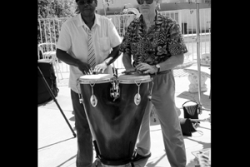
To meet musician, instructor, educator, percussionist, and philanthropist, Dr. Craig Woodson is like meeting his ancestor, Carter. G. Woodson. Dr. Woodson confidently stated and without revocation, that we are all indeed mammals originating from the same earth of Africa.
A man of gentle nature, Dr. Woodson is a global explorer and has a natural flair for gathering ancient teachings that take notice of all strains of music and sound, and even more-so on, percussions. He is the founder of Roots and Rhythm a Cleveland based organization. Dr. Woodson works closely with the NAMM Foundation. He presented his Roots of Rhythm program to “Remo Recreational Music Center,” of North Hollywood, while visiting Los Angeles.
Jimmie James on the other hand, is a local resident and musician who said that after having a dream he came up with the design of the world’s first, two-headed drum, made with only one piece of wood. James’ earlier inventions started at age 10 and included a subwoofer made out of an old conga drum with a speaker inside. James being unaware of his creation plugged the speaker into a speaker system, but it was so loud that he had to leave the room. Those early beginnings of successes and sometimes failures did not stop James from pursuing other types of inventions, which led him to the patent, and packaging of the planet’s first twoheaded drum.
No one believed that James could come up with a design. When the drum appeared in his dream he knew that the sound would be exactly. This happened in 2008. After keeping his concept to himself for a year, James hit the ground running with his two-headed drum, approaching “Remo,” and at that time, a record store called “Motherlands Music.”
The other companies did not believe that James had created a drum with two-heads; however, Dan Rice at Motherlands gave his support by sending the new product to Ghana on James’ behalf. Someone in Ghana was able to turn the drum’s design around for James’ approval in just a months’ time. Now that all of the patents are in place for the two-headed drum, James is waiting to hear back from sponsors like industry icon, Dionne Warwick, who is writing a letter of endorsement for the drum. More recently, James’ invention met with approval from President Obama.
The history of the drum goes as farther back than slavery. Dr. Woodson studied African drums in the 1960s and whenever they would break, he would fix them. After a while he began making prototypes of new designs. On his way back from North Africa during the 1970s, Dr. Woodson saw fiberglass and plastic drumheads in Africa and decided that if the Africans could do it, then so could he.
After getting into higher technology, he got an invite to go to Ghana and work for three years at The University of Science and Technology, which was the center for cultural studies. There Dr. Woodson directed the Music and Instrument Technology workshop, which would become a program being offered 30 years later. The workshop included making all types of instruments, even percussions. Dr. Woodson and his staff would go out and rescue instruments like the Seperewa, a class of harplute chordophones and string instruments that were disappearing due to under use. Since Dr. Woodson’s research, those musical treasures have made a resurgence.
That experience was the beginning of a lifelong love affair between Dr. Woodson, Africa and his showing young people how to make their own musical homemade tools for sound. He began a demonstration of various talking drums such as the “Dondo,” which is a drum that has a change in pitch when squeezed. Dr. Woodson wanted to make a simpler version of the “Dondo” and so he created the technology to use two large metal cans, the same ones that you can find from a pizza store, embroidery hoops, and packing tape.”
“Kids in Africa will take rubber from a tree, and wrap it around a can and make a drum,” Dr. Woodson said. It is worth noting that the drumhead can be firmly secured with the packaging tape by using a crisscross pattern. In the process of Dr. Woodson’s teaching children to make their own music, a series of instructional manuals came to be and the doctor after an invite, wrote, “Roots of Rhythm World Drumming for All Ages.
“Chapters 1-10 of the series of manuals can be found online, free of charge.at www. rootsofrythm.net. The books were created for the Percussion Marketing Council and the NAMM Foundation, which have been underwriting the doctor’s instructional manuals for 10 years. Dr. Woodson has taken the series of instructions on the making of percussions, nationally, to teacher workshops, making it easier to teach all who want to learn. He calls upon experts of various cultures to approve the manuals.
Kevin Locke, a famous hoop dancer read the Native American drum and made the necessary changes, and although the manual are for teachers, anyone can use it. Dr. Woodson gave a quick demonstration of the Tonbak of Iran, which dates back 2,000 years. The Tonbak is usually used for poetry and classical music and is played diagonally across the torso and the player uses the fingers and palm of the hand. The different sounds or The United States outlawed all drums including peace pipes used by Native Americans. An African message can be transmitted at the speed of 100 miles within an hour. According to James, if caught smoking a peace pipe or playing a drum, one could go to jail. Dr. Woodson’s ancestors came to the country in 1619 and in 1620 the family brought six of the first 20 Africans that arrived in the US. In 1998 the descendants of all Woodson’s both white and black met on Dr. Woodson’s behalf, in order to give a public apology for their part in slavery. The Ashanti people, of whom, Dr. Woodson had worked with in Africa were invited, as to they were the slave contributors from Ghana.
The meeting and public apology offered by both sides of the Woodson family set the stage for the healing that has to happen, in order for us all to truly be free.
For more information on Dr. Craig Woodson Drums of Humanity and the Roots of Rhythm program, search www.rootsofrhythm.net woodsonphd@ gmail.com, www. EthnomusicInc.com, www.RootsofRhythm.net and www. DrumsofHumanity.org.
For James and his twoheaded drum persons can contact twodrumsjimmie@yahoo.com or call (323) 939-2658.












